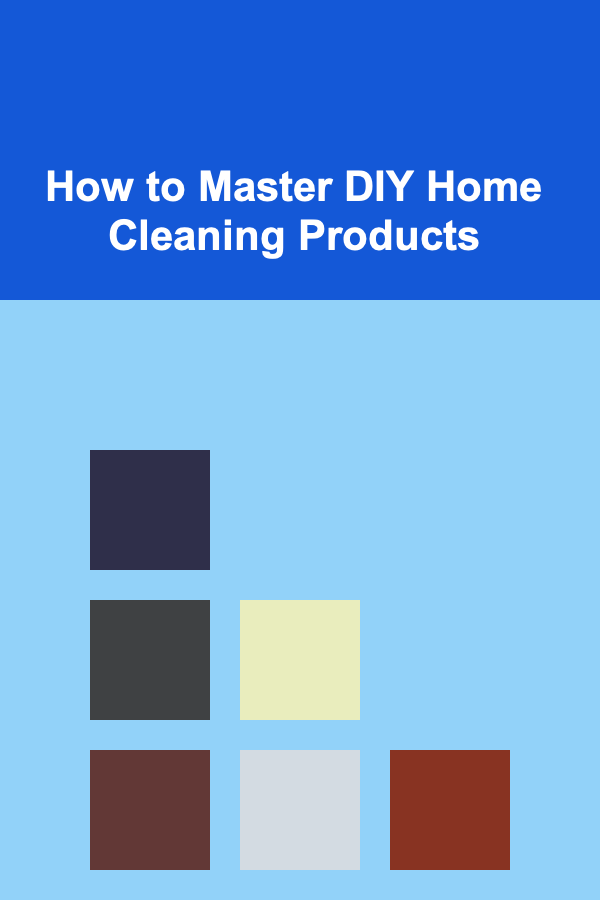
How to Master DIY Home Cleaning Products
ebook include PDF & Audio bundle (Micro Guide)
$12.99$9.99
Limited Time Offer! Order within the next:

In the age of eco-conscious living, rising consumer awareness about harmful chemicals, and the desire to reduce household costs, making your own cleaning products has become an increasingly popular option. DIY home cleaning products are an excellent way to create a safer, more sustainable environment while saving money and reducing your exposure to potentially harmful chemicals. However, mastering DIY home cleaning products involves more than just mixing a few ingredients together---it requires understanding the science behind cleaning, the right proportions, and the proper techniques. In this article, we'll explore how you can master the art of making your own cleaning products at home.
The Benefits of DIY Home Cleaning Products
Before we delve into the practical aspects, let's first explore why more and more people are turning to DIY cleaning products.
1. Healthier Living Environment
Traditional cleaning products often contain chemicals like ammonia, bleach, and phthalates, which can irritate the skin, eyes, and respiratory system. Over time, these chemicals can accumulate in the air and on surfaces, posing potential risks to your health. DIY cleaning products, on the other hand, typically use natural ingredients like vinegar, baking soda, and essential oils, reducing the chances of exposure to harmful chemicals.
2. Cost-Effective
Commercial cleaning products can be expensive, especially when you consider the cost of purchasing multiple specialized cleaners for different tasks. By making your own, you can purchase ingredients in bulk, making them last longer and significantly reducing the overall cost of cleaning supplies.
3. Environmental Impact
Many store-bought cleaning products come in plastic containers that end up in landfills, contributing to plastic pollution. By opting for DIY cleaning products, you can reuse containers and reduce your carbon footprint, making your cleaning routine more sustainable.
4. Customization
DIY cleaning products allow you to customize your formulas to suit your specific needs. Whether you're dealing with hard water stains, greasy kitchen surfaces, or dust allergies, you can adjust the ingredients to target the problem at hand. Additionally, you can experiment with various essential oils to create your own signature scents.
Understanding the Basics of DIY Cleaning Ingredients
Before creating DIY cleaning products, it's essential to understand the basic ingredients involved. Many of these ingredients serve dual purposes, acting as both cleaning agents and natural disinfectants.
1. Vinegar
Vinegar, specifically white distilled vinegar, is one of the most versatile ingredients in homemade cleaning solutions. It has natural antibacterial properties, can dissolve mineral deposits, and works as a natural degreaser. Additionally, vinegar can neutralize odors, which makes it perfect for eliminating unwanted smells in kitchens and bathrooms.
2. Baking Soda
Baking soda, or sodium bicarbonate, is a natural abrasive that can scrub away dirt and grime without damaging surfaces. It also neutralizes odors and acts as a mild disinfectant. Baking soda is particularly useful in kitchens and bathrooms, where heavy cleaning is often needed.
3. Castile Soap
Castile soap is a plant-based soap made from olive oil and is often used as a base in DIY cleaning products. It is gentle on the skin but effective at breaking down oils and grease, making it suitable for a variety of cleaning tasks, from dishwashing to surface cleaning.
4. Lemon Juice
Lemon juice has natural bleaching properties, which can help brighten surfaces and remove stains. It is also an effective deodorizer and has antimicrobial qualities that help kill bacteria and fungi. Lemon juice can be combined with other ingredients like vinegar or baking soda for an extra cleaning boost.
5. Essential Oils
Essential oils are highly concentrated plant extracts that not only add pleasant scents to your cleaning products but also bring additional cleaning properties. For example, tea tree oil has antibacterial and antifungal properties, while lavender oil is known for its calming effects and antimicrobial benefits. Common essential oils used in cleaning include tea tree, lavender, lemon, eucalyptus, and peppermint.
6. Hydrogen Peroxide
Hydrogen peroxide is a powerful disinfectant with antimicrobial properties. It can be used to clean surfaces, whiten fabrics, and even sanitize items like cutting boards and bathroom fixtures. However, it should be used with caution, as it can bleach certain fabrics and materials.
Recipes for Effective DIY Cleaning Products
Now that you're familiar with the basic ingredients, let's look at some of the most effective DIY cleaning recipes that you can easily make at home. These recipes target various cleaning needs and can be customized based on your preferences.
1. All-Purpose Cleaner
An all-purpose cleaner can be used on countertops, sinks, and other hard surfaces in your home. Here's how to make it:
Ingredients:
- 1 cup white vinegar
- 1 cup water
- 1 tablespoon baking soda
- 10-15 drops of essential oil (e.g., lavender, lemon, or tea tree)
Instructions:
- In a spray bottle, mix the vinegar and water.
- Add the baking soda and shake the bottle to combine.
- Add the essential oils for fragrance and shake again.
- Spray directly onto surfaces and wipe clean with a cloth.
2. Glass Cleaner
This glass cleaner is streak-free and gentle enough to use on windows, mirrors, and other glass surfaces.
Ingredients:
- 1 cup water
- 1 cup white vinegar
- 1 tablespoon cornstarch (optional, for extra shine)
Instructions:
- Mix all ingredients in a spray bottle.
- Shake gently before use to combine the cornstarch (if using).
- Spray directly onto glass surfaces and wipe with a lint-free cloth or newspaper.
3. Bathroom Cleaner
Bathrooms can accumulate grime, soap scum, and mineral deposits, but this natural cleaner can tackle those problems.
Ingredients:
- 1/2 cup baking soda
- 1/4 cup white vinegar
- 1 tablespoon dish soap (preferably castile soap)
- 1/2 cup water
- 10 drops of essential oils (optional)
Instructions:
- Mix the baking soda, dish soap, and water in a spray bottle.
- Slowly add the vinegar to the mixture, allowing it to fizz.
- Add the essential oils for fragrance and shake the bottle gently.
- Spray the cleaner on bathroom surfaces like the tub, toilet, or sink, and let it sit for a few minutes before scrubbing and rinsing.
4. Carpet Cleaner
If you're looking to freshen up your carpets or upholstery, this DIY cleaner is an excellent option.
Ingredients:
- 1 cup baking soda
- 10 drops of essential oil (e.g., lavender or eucalyptus)
- 1/2 cup white vinegar
- 1 cup water
Instructions:
- Sprinkle baking soda evenly on the carpet or upholstery.
- Mix the vinegar and water in a spray bottle and lightly spray over the baking soda.
- Let the mixture sit for about 15 minutes.
- Vacuum the area to remove the baking soda and dirt.
5. Disinfectant Spray
For sanitizing high-touch surfaces like doorknobs, light switches, and phones, this disinfectant spray works wonders.
Ingredients:
- 1 cup water
- 1/2 cup rubbing alcohol (70% or higher)
- 1 tablespoon hydrogen peroxide
- 10-15 drops of essential oil (optional)
Instructions:
- Mix the water, rubbing alcohol, and hydrogen peroxide in a spray bottle.
- Add essential oils for fragrance (optional).
- Shake well and spray on surfaces to disinfect, wiping away any excess with a clean cloth.
6. Wood Polish
This simple wood polish brings a natural shine to wooden furniture and surfaces.
Ingredients:
- 1/4 cup olive oil
- 1/4 cup white vinegar
- 10 drops lemon essential oil
Instructions:
- Mix all ingredients in a small spray bottle.
- Spray a small amount onto a soft cloth and rub into wooden surfaces.
- Buff the wood with a dry cloth for a polished finish.
Best Practices for DIY Home Cleaning
To make the most out of your DIY cleaning products, here are some best practices to keep in mind:
1. Use the Right Tools
Using high-quality cleaning tools like microfiber cloths, soft sponges, and scrubbing brushes can make a big difference in the effectiveness of your DIY cleaners.
2. Proper Storage
Store your homemade cleaning products in a cool, dry place, and always label your bottles. For products that contain essential oils or vinegar, ensure they're kept away from direct sunlight, which can break down some ingredients over time.
3. Test New Formulas
When trying a new DIY cleaner, test it on a small, inconspicuous area of the surface first to ensure it doesn't cause any damage.
4. Avoid Mixing Certain Ingredients
Some common cleaning ingredients, such as vinegar and hydrogen peroxide, can react with each other and reduce their effectiveness. Stick to one active ingredient per recipe when possible, or research safe combinations.
5. Adjust According to Need
Feel free to adjust the amount of essential oils, baking soda, or vinegar in your recipes based on your preferences for scent, texture, and cleaning power.
Conclusion
Mastering DIY home cleaning products isn't just about mixing ingredients---it's about understanding the science of cleaning and the importance of using natural, non-toxic substances. By making your own cleaning solutions, you're not only reducing your carbon footprint and saving money, but you're also creating a healthier home environment. With a little bit of time, effort, and experimentation, you'll soon be a pro at making your own effective, eco-friendly cleaning products.

Building AI-Powered Tools for Passive Income Generation
Read More
How to Add Color to Your Home Decor Without Spending a Lot
Read More
How to Build an Email List for Your Blog and Website
Read More
How to Choose the Best Holiday Decorations for Small Apartments
Read More
How to Create a Checklist for Email Campaign Automation
Read More
10 Tips for Organizing Your Sewing Planner for Maximum Productivity
Read MoreOther Products

Building AI-Powered Tools for Passive Income Generation
Read More
How to Add Color to Your Home Decor Without Spending a Lot
Read More
How to Build an Email List for Your Blog and Website
Read More
How to Choose the Best Holiday Decorations for Small Apartments
Read More
How to Create a Checklist for Email Campaign Automation
Read More